
|   |

|   |
Soor Mandir celebrates Art, culture, and a confluence of dance styles at the 25th Raja Mahotsaba - Maya Krishnamurty e-mail: maya.krishnamurty@gmail.com Photos: Manas Babu July 12, 2023 The Silver City Kataka or Cuttack is all-encompassing as a historical, commercial, and cultural centre in the annals of Odishan history. And it continues to preserve its own identity with its distinctive cultural mores, social milieu, and tradition of festivals. This year marked the 25th successive year of the celebration of one such festival, Raja Mahotsaba by Soor Mandir, under the direction of Dr. Jyotsna Sahoo. Hosted at Saheed Bhawan, Cuttack from June 15 to 18, 2023, Raja Mahotsaba featured a mix of solo, duet, and group dance presentations, primarily of Odissi dance, but interspersed with Kuchipudi, Kathak, and signature Raja dances. Day 1 - June 15, 2023 Celebrating the sanctity and beauty of womanhood and the commencement of a new agricultural year, Raja Parba is integral to the lives of the Odia people. On the occasion of the silver jubilee of Raja Mahotsaba, Soor Mandir presented a lifetime achievement award to Soorya Krishnamoorthy, founder of the Soorya foundation for his contribution to Art and culture. He received a citation and cash award of Rs. 25,000. During this festival that celebrates and acknowledges the power of the divine and telluric feminity, the "Shreshtha Odiani" Samman was presented to three women who are making a difference in their fields through their social and cultural activism. Founder-president of Parichay Foundation for women empowerment and Parineeti for women weavers Dr. Rosalin Patasani Mishra; Proponent of Mayurbhanj Chhau and founder of Utsa foundation Subhasree Mukherjee, and Ollywood icon and social activist Elina Dash received the Priya Odiani titles 2023.  Raja dance—Suna Bhauja by students of Soor Mandir With over 70 students entering and exiting the stage in different group formations and sequences, Soor Mandir began their Raja cultural programme dancing to the tunes of Suna Bhauja, a music track by Prem Anand. Thereafter, the formal Odissi presentations of the evening began. It was a befitting commencement by Guru Aruna Mohanty, noted senior Odissi exponent and Guru, and President, Odisha Sangeet Natak Akademi. She performed Ashwatthama, an exploration into the depths of the star-crossed character, who was "cursed" to immortality by Lord Krishna when he indiscriminately slaughtered the Pandava sons stealthily in the dead of the night disregarding the accepted conduct of warfare and morality. 
Guru Aruna Mohanty presents Ashwatthama The impactful iterations of "Mukti…Mrutyu…Mrutyu…Mukti," depicted through different sancharis by Guru Aruna brought out the angst of Ashwatthama. Aruna Mohanty lived the eternal life of Ashwatthama for over a thousand cursed and miserable years, longing for liberation and release through death. Born a Brahmin, his greatness as a warrior in the Mahabharata turned out to be the anathema of his existence, as he fought for his place amidst the Kauravas and later fell from grace for his furtive attack on the Pandavas (in supposed revenge for his father Guru Dronacharya's death). The complexity of his character was brought to life as she depicted the despair of Ashwatthama through his rites of passage in war and in life. In one seamless depiction, she brought out the proficiency, ego, wounded pride, and existential quandary of this single character that was Ashwatthama, cursed to be "blessed with eternal life." Scripted by Kedar Mishra, the nuanced choreography of Ashwatthama was designed by Guru Aruna Mohanty to the music composition of Guru Ramhari Das and rhythm composition of Guru Dhaneswar Swain. The musical accompaniment was ably provided on vocals by Rupak Kumar Parida, mardala by Guru Dhaneswar Swain and Guru Bijay Kumar Barik, tabla by Ajay Kumar Choudhury, violin by Agnimitra Behera, flute by Srinibas Satapathy, sitar by Prakash Chandra Mohapatra, and keyboard by Bibhu Prasad Tripathy. The credits for the dramatic yet realistic light design were accorded to Ramesh Chandra Jena.  Guru Ratikant Mohapatra and Preetisha Mohapatra After this intense dance ouverture, the audience witnessed what one could call the piece de resistance of the evening—it was the first time the father-daughter jugalbandi of Guru Ratikant Mohapatra (Director, Srjan and Dean, Faculty of Arts, Communication and Indic Studies, Sri Sri University) and Preetisha Mohapatra would take the stage together in a duet. They presented Jatayu Moksha, one of the most moving episodes from the Ramcharitamanasa of Poet Tulsidas. Ravana kidnaps Sita and spirits her away to Lanka in his Pushpaka Vimana, destroying the wings of Jatayu, who valiantly tries to save her. When Jatayu laments his inability to rescue Sita, Lord Rama grants him the ultimate salvation for his heroic efforts. In this piece, both Guru Ratikant and Preetisha switch roles, assuming different personae, first with Guru Ratikant portraying the villainous Ravana with élan, and Preetisha, the helpless Sita. They later deftly change characters, as Guru Ratikant assumes the gallant Jatayu, who despite his best efforts gets mauled by the evil Ravana, now played by Preetisha. The impassioned dance presentation was deep in content and engaging in its exposition. This choreography by Guru Ratikant Mohapatra was set to the captivating music composition of Pandit Lakshmikanta Palit in Ragamalika and Talamalika. The presentation was ably aided by Debiprasad Mishra's distinctive light design.  Jyoti Kala Mandir performing Hara Chandi Malasi With these intensely emotive solo and duet dance performances kick-starting the festival, the prekshaka could feel the blessings of the Almighty and Guru on the stage as Guru Jyoti Rout and her students from Jyoti Kala Mandir concluded the dance performances for the evening with group presentations by the performing ensemble of Jyoti Kala Mandir, Bhubaneswar and a solo by Jyoti Rout, who ably divides her time in imparting an education in Odissi dance in both California, USA and Bhubaneswar, Odisha. On the auspicious occasion of Raja, Jyoti Kala Mandir commenced their group presentation in obeisance to Devi Bhagawati, the presiding Goddess of Shri Kshetra, in a dance that traces its roots through the centuries to the Ashta Chandi parampara of Shri Kshetra and Odisha. The group presented Hara Chandi Malasi, choreographed by Guru Jyoti Rout to the music composition of Dr. Bijay Kumar Jena and rhythm composition of Guru Satchidananda Das. The dancers entered with irradiant lamps in either hand to the resounding sound of the temple gongs that emulated the Arati characteristic of a temple ambience and an invocation. In glory of the power of the divine feminine, the refrain Jaya Harachandi Atanka Nashini, Jaya Jaya Adi Mata, "Victory to Hara Chandi, the destroyer of fear. Glory to the omnipotent, immortal mother," the choreography illustrated striking episodes of the Devi's conquest over evil through group formations and the dance itself. 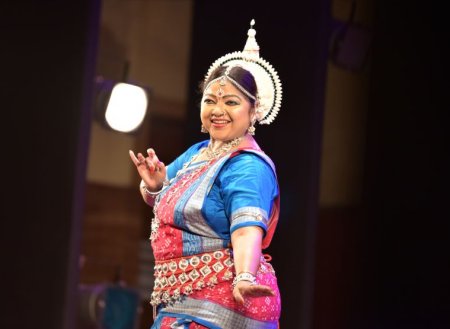 Guru Jyoti Rout in Bindu Guru Jyoti then presented the contemplative piece, Bindu, which brought to the mind of the viewers the inherent concept of Brahman and the aphorism, "You are not a drop in the ocean, you are the ocean in a drop." Painting the notion of drops of water coming together to make an ocean and equating that to the notion of the emergence and dissolution of the self, Jyoti Rout's heartfelt rendition of Bindu traced the story of a single drop, forming the sea in multitude, rising to the expanse of the sky as clouds, and making its home-coming back to the soil and the vast oceans of blue, as the rains. And just as several drops of water form the deep blue sea, we, as minute specks of dust in this expansive universe come together to make up the infinite cosmos. The metaphysical concept Bindu found fruition in the Odissi idiom through the choreography of Guru Jyoti Rout set to sitarist Swapneswar Chakraborty's music composition and mardala exponent Guru Dhaneswar Swain's rhythm composition. Jyoti Kala Mandir concluded with Mani Bimane Govinda. The dance described the festivities of the annual Chandan Jatra at Puri, in which the idol of Radha, Krishna, and other deities are taken on a boat ride around the Narendra Pushkarini in their gem-studded carriage, the Mani Vimana that swings from side-to-side with the rolling gait of the palanquin bearers. Set to the music composition of Swapneswar Chakraborty and rhythm composition of Guru Satchidananda Das, Jyoti Rout presented her choreography with the dancers of Jyoti Kala Mandir, Monika Samantaray, Sampada Mishra, Sreejita Mohanty, Meerashrita Das, Asharani Samantaray, Ankita Priyadarshini, Sradhanjali Rath, and Ananya Das. Day 2 - June 16, 2023 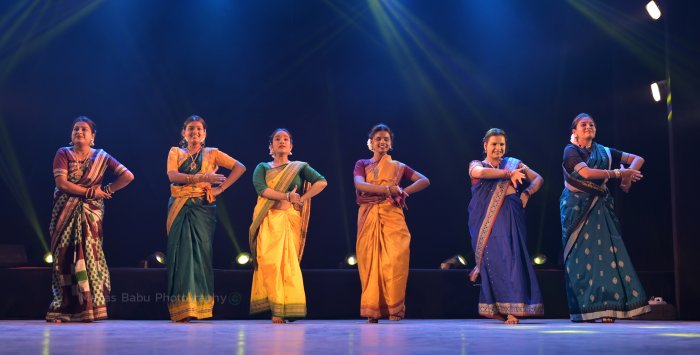 Doli re Doli by students of Soor Mandir 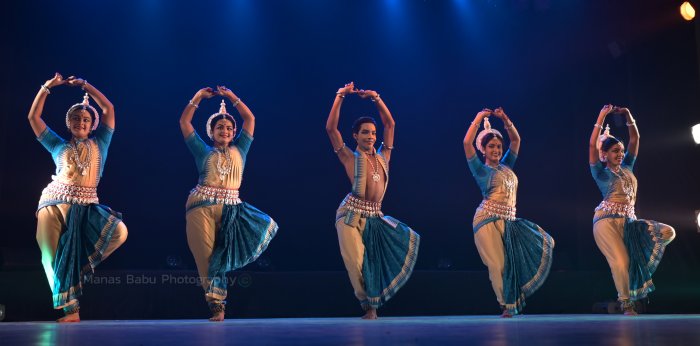 Shreeram The second day witnessed an exclusive evening of Odissi by Soor Mandir, trained by festival convenor and host, Jyotsna Sahoo. After a short Raja dance titled Doli re Doli by the students of Soor Mandir, presenting the vibrant flavour of Raja, the performing ensemble commenced their recital with Shreeram, Namami Bhakta Vatsalam, from the Aranya Kanda of Saint Tulasidas' Ramcharitamanasa, in reverence to Lord Rama. This panegyric illustrated the several majestic qualities of Lord Rama in group formations and ended with the devotional chanting of Lord Rama's name. A memorable invocation in Ragamalika and Khemta Tala, Shreeram was followed by a nritta piece, Kirti Kalavati Pallavi based on raga Kalavati and adi tala in a 16-beat cycle. In varying permutations of six and seven artistes, the dancers, Shambhabi Mohapatra, Chinmaya Das, Sonali Das, Mayuri Krishna Sahoo, Roopsa Kahali, Lipsa Mahapatra, Rinabala Lenka, Debasmita Mahana, and Supriya Priyadarshini presented these compositions with good coordination and energy to the choreography of Dr. Jyotsna Sahoo, music composition of Swapneswar Chakraborty, rhythm composition of Guru Satchidananda Das, and the musical overview of Dr. Srinibas Ghatuary.  Soor Mandir in Sri Ranga Charana This was followed by a presentation of the auspicious Ardhanarishwara Stotram based on a composition by Adi Guru Shankaracharya. Dancers Chinmaya and Shambabi presented this choreograph with synchronous movements and crisp footwork, bringing out the contrasting male and female principles of Shiva and Shakti through the iconography of Ardhanarishwara. The penultimate performance was Sri Ranga Charana, a glorious homage to deities Rama, Krishna, and Jagannath across the Yugas, enacting the several stories of their divinity. Choreographed by Dr. Jyotsna Sahoo to Swapneswar Chakraborty's music composition, Sri Ranga Charana depicted the liberation of Ahalya from her cursed existence as a stone; the kewat (boatman) ferrying Lord Rama across the river Ganga; the episode of Kaliya Mardana, and concluded with the dancers seeking the ultimate salvation in this Kali Yuga, by surrendering at the lotus feet of Jagannatha Mahaprabhu, the Lord of the Universe. Koyalika Majumdar joined Shambhabi, Chinmaya, Sonali, Mayuri, Roopsa, Lipsa, Rinabala, Debasmita, and Supriya in this presentation, which took the form of an agreeable mini dance drama. 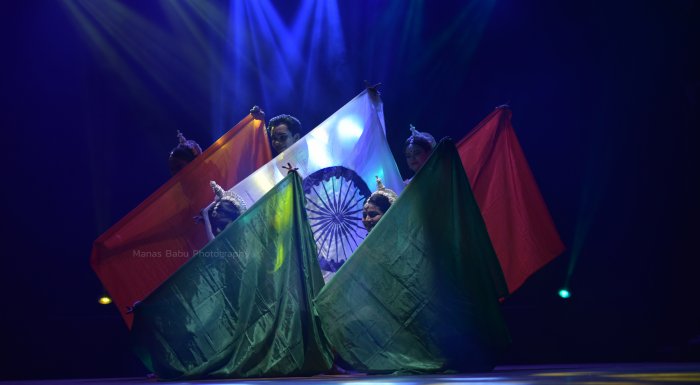 Vande Mataram Vande Mataram, an ode to the motherland set to violinist Agnimitra Behera's more modish rendition of this classic, completed the evening. The dancers began with a striking display of the colours of our sacred Tiranga. Akin to the original choreography of Guru Kelucharan Mohapatra, Jyotsna Sahoo's choreograph highlighted the age-old themes of the historical splendour and values of our nation in this memorable composition of Bankim Chandra Chattopadhyay. 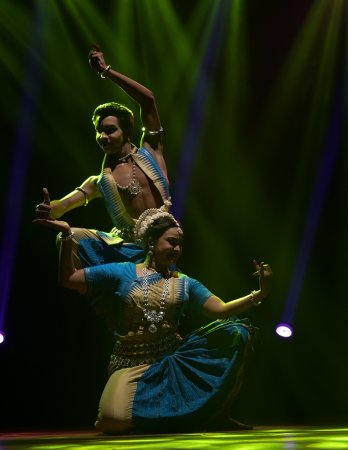 Ardhanarishwara by Chinmaya and Shambabi Soor Mandir's well-designed programme made for a delightful evening of Odissi. The dancers were well-trained and coordinated in all their presentations. The stand-out was Chinmaya Das, who was present in all the dances through the evening and maintained a constant graph of energy from start to finish. However, as an Odissi dancer who is familiar with Ardhanarishwara Stotram and other compositions, I could not help but notice certain obvious similarities between the duet of Ardhanarishwara Stotram as composed by Guru Ratikant Mohapatra, and the dance presented by Chinmaya and Shambabi. The credits were given to legendary Guru Kelucharan Mohapatra for choreography and Pt. Raghunath Panigrahi for his enchanting music composition. Ardhanarishwara was composed by Guruji in 1977 for none other than Sanjukta Panigrahi, who immortalized the solo choreography. It may be noted that Guruji never composed a duet or a group presentation for this timeless Stotram. Thus, the larger audience could have possibly been misled by this introduction. The renewed duet composition of Ardhanarishwara by Dr. Jyotsna Sahoo, sung by Dr. Bijay Kumar Jena and Harapriya Swain, would have been a more befitting introduction. In the words of Guru Ratikant Mohapatra, acknowledging the usage or adaptation of his duet composition as the inspiration for this presentation and crediting the synopsis of Aditya Mahapatra whose unmistakable turn of verse was quoted almost verbatim in the recorded prelude would have made the dance all the more memorable. This is not to take away from the efforts and synergy of the dancers, who captured the audience attention with their laudable presentations. Day 3 - June 17, 2023  Raja dance by Soor Mandir  Sakhi He by Purnashree Rout On the penultimate evening, Soor Mandir once again began with a signature Raja tune and composition, swaying to the notes of Maati Amara Maa, in homage to Mother Earth. This was followed by the first Odissi presentation of the evening, a solo by Purnashree Rout from Raipur. She presented the sixth prabandha of 12th-century poet Jayadeva's magnum opus the Geeta Govinda, Sakhi he keshi mathana mudaram, choreographed in its original form by Guru Kelucharan Mohapatra and set to the music composition of Pt. Bhubaneswar Mishra in raga Mishra Khamaj in the fourteen-beat cycle of Jati tala.  Prahalada Nataka by T Reddi Lakshmi New Delhi based Kuchipudi dancer T Reddi Lakshmi then presented Prahalada Natakam as a solo Kuchipudi Yakshaganam number. Beginning with the pravesha daruvu or arrival of Hiranyakashipu in his court, dressed in raiment that exudes the brightness of a thousand resplendent suns, the narrative proceeds to his fury at his son Prahalad's devotion to Lord Vishnu. In his incarnation as Narasimha, Lord Vishnu vanquishes Hiranyakashipu, as his ardent devotee Prahalad remains steadfast and loyal to his Lord even in the face of danger and death. While this familiar narrative needs no elaboration, Lakshmi presented the composition in two parts, the first being the pravesha daruvu and the second interspersed with dialogues between the characters, that came together to constitute the full-fledged story. Under the guidance of her Gurus Jayarama Rao and Vanashree Rao, and with training from Guru Ramalinga Shastry (for the portion presenting Hiranyakashipu's pravesha), this presentation used Telugu dialogues set to traditional Kuchipudi music. Musical accompaniment on record was by Guru Jayarama Rao on the nattuvangam, Satish Venkatesh on vocals, Tanjavore R Kesavan on the mridangam, Rajat Prasanna on the flute, and Raghavendra Prasath on the violin. 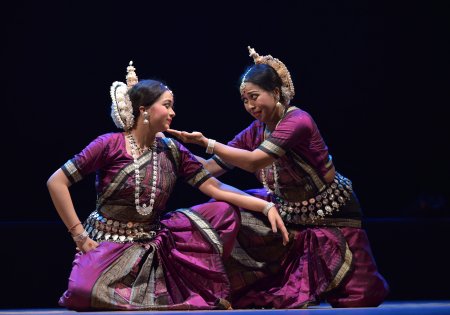 Madhusmita Mohanty and Tanisha Tanushree The two solo performances were followed by the mother-daughter duo of Madhusmita Mohanty and Tanisha Tanushree, in the Odissi dance style. They presented two pieces in the signature style of the well-known Orissa Dance Academy, Bhubaneswar, under the guidance of Guru Aruna Mohanty. They commenced their recital by invoking the blessings of Lord Jagannath with a short prayer and moving on to Panchabhuta, invoking the five cardinal elements of nature, namely Earth, Water, Fire, Air, and Ether, the basis of all cosmic creation. The original choreography of Guru Gangadhar Pradhan was designed as a duet by Aruna Mohanty to the music composition of Ramhari Das and rhythm of Dhaneswar Swain. With evocative imagery and short sequences for each element, their presentation of Panchabhuta was followed by Madhurashtaka, the popular Sanskrit octet in praise of Lord Krishna, written by 15th century Bhakti saint, Vallabhacharya. Their jugalbandi described the several ambrosial qualities and deeds of Lord Krishna who in the eyes of the devotee, is sweetness personified. The devotee surrenders in supreme devotion to the lord. A composition of Guru Pankaj Charan Das directed as a duet by Aruna Mohanty, and set to the music composition of Harihara Panda, Madhurashtaka was presented with endearing chemistry between Madhusmita Mohanty and Tanisha, who brought out their own personality to the fore through their performance. They were aided in their presentations by the vibrant light design of Ramesh Chandra Jena. The finale for the evening was the presentation of Chhota Mora Gaan Ti (My Small Village) by one of Odisha's most prolific writers and poets, "Biplabi Kabi" or revolutionary poet, Sachidananda Routray. Guru Niranjan Rout's Nupur presented this dance drama, the music for which was rendered by Ramhari Das, rhythm was composed by Dhaneswar Swain and Ajay Choudhury, and script overview was by Dr. Srinibas Ghatuary. The melodious vocal accompaniment was rendered by Ramhari Das, Nimakanta Routray, and Kshiti Prakash Mohapatra.  Nupur in Chhota Mora Gaan Ti In this dance drama, Guru Niranjan assumed the role of the sutradhara and poet, exuding the image of the dignified and sapient poet who narrates his nostalgia, love, and longing for his place of birth and belonging. From ashes to ashes, and dust to dust, we come a full cycle and return to the place that we call home. An idyllic depiction of the poet's "small" and beloved village, Chhota Mora Gaan Ti was portrayed by the dancers of Nupur, Akankhya Das, Pritika Parida, Aishwariya Mohanty, Aeioush Gunaprava and Sanjana Gowda dressed in Odisha cotton saris, as opposed to the traditional Odissi costume dancing to colloquial tunes, very much within the aura of the state of Odisha, but not in the classical idiom. The presentation could be viewed as homage to Maati, our mother, the soil of our birth, viewed from the lens of patriotism and belongingness. After the veneration to mother Earth with paeans of praise, the dance shifted to one of the most popular motifs of Guru Sachi Routray's work, rebellion against the Raj. Artists Bibhu Prasad Behera, Prahlad Sahoo, Dipti Prakash Champati, and Suresh Sendha performed the Paika sequences, illustrating the glorious warrior clan and their struggles in protecting their Maati, their land, and the episode of the Paika Bidroha (Paika rebellion) under the leadership of Buxi Jagabandhu, against the East India Company in the 1800s, and the fight to achieve freedom and emancipation from them, to protect their motherland. Day 4 - June 18, 2023 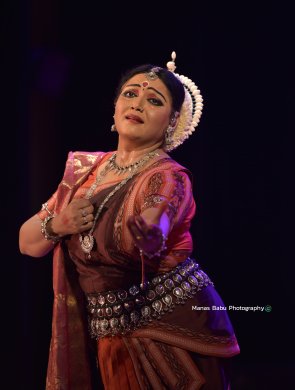 Shweta Mukti by Guru Kavita Dwibedi Soor Mandir's 25th Raja Mahotsaba drew to a close on June 18 with its fourth day of celebration of dance and culture. The performances for the evening commenced with a solo Odissi dance production by Guru Kavita Dwibedi, senior Odissi exponent and founder-director of Odissi Akademi, New Delhi. She performed Shweta Mukti, highlighting the feminine glory of Nirvana through an intricate exploration of three seminal women in Siddhartha Gautama's life, each of whom attained self-actualization and liberation through their own unique journeys. The piece comprised the three episodes of Gautama's foster mother Gautami, his queen Yashodhara, and a young girl from a marginalised community, Prakriti. The very title Shweta Mukti connotes a reference to Buddhism, and the notions of purity and liberation from the shackles of the world, and through her choreography, Kavita Dwibedi brought these out in her character distinctions. She chose to symbolically distinguish Gautami, Yashodhara, and Prakriti through different Angavastras draped over her sari that reflected the characters' respective places in society. The nuanced portrayal of Gautami showed her vatsalya shringara towards her foster son, her remembrances from his childhood, and the resignation and sadness at his decision. With Yashodhara came the element of beauty and majesty, and love towards her husband, whom she realises, cannot be caged within the confines of an imperial palace. Shweta Kapota, "Oh, my white dove," she addresses him, "Oh enlightened one, show me the path to mukti." The symbolism of the white dove freed into the infinite skies, and of Yashodhara's transition from love, to the pain of separation, and then acceptance on the path to liberation and peace were depicted in this episode. The third and final episode was that of Prakriti, who, due to her caste, explained her inability to provide water to Buddha when he passed her by. The Buddha bequeaths to all, absolution from their worldly trials, fulfilling their longing for mukti and moksha. Based on her own concept and choreography, Kavita Dwibedi designed Shweta Mukti to the music composition of Ramhari Das, rhythm composition of Dhaneswar Swain, and the Odia lyric of Kedar Mishra. Acknowledging the impermanence and transient nature of our lives, concluding Shweta Mukti with the meditative refrain, Buddham Sharanam Gacchami seemed appropriate. In an interesting parallel, the inaugural day began with the character of Ashwatthama seeking his ultimate salvation, followed by the duet presentation of Jatayu Moksha, and the final day witnessed Gautami, Yashodhara, and Prakriti's quest for nirvana. In our ultimate pursuit to break out of the ocean of samsara and attain our escape from the mortal cycle of life and death, each individual's unique journey to break out of this cycle provides for a vast sahitya to explore in our itihasa, and delve deep into its myriad manifestations through our Art. 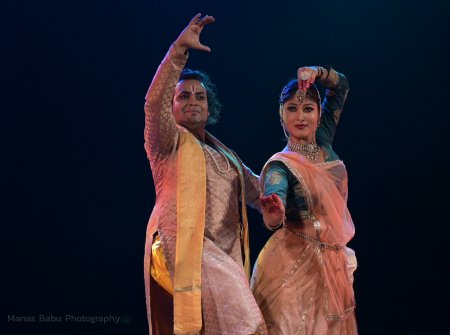 Anuj Mishra and Neha Singh Mishra In the only Kathak performance of the festival, Anuj Mishra and Neha Singh Mishra of the Lucknow gharana brought forth distinctive presentations of their gharana from Lakshmanpuri, Lucknow, as composed by legendary Gurus of Kathak, Pandit Bindadin Maharaj and Guru Arjun Mishra. With the blink of an eye and their numerous powerfully executed pirouettes, their recital spanned four short and memorable compositions, commencing with a dedication to Lord Nataraja Shiva-Shakti. In a beautiful dissimilitude of the various facets of Shiva and Shakti, three distinct forms were depicted by Anuj Mishra and Neha Singh Mishra, as composed by Pt. Arjun Mishra and Anuj Mishra, set to the music direction of Pt. Dharam Nath Mishra in raga Jog and Teen Taal. They began with an excerpt of the powerful Shiva Yajur Mantra, Karpura Gauram Karunavataram… depicting the divinity and sanctity of the Lord and his Ardhangini, who are the supreme forces that harbour the universe under their auspices. The second facet was that of the invigorated Tandava, the Raudra Tandava, as seen in the powerful Shiva Tandava Stotram Jatatavi galajjala pravaha pavita sthale; and the third contrasting aspect of Anandamayi Shiva, in his majestic and auspicious state. In what Anuj Mishra described as the forays into technical or traditional Kathak for the evening, they presented an amalgam of compositions of the Lucknow gharana by Pt. Arjun Mishra and Anuj Mishra set to teentaal (16-beat cycle) beginning with a Vilambit (slow) and Madhya (medium) Laya aarambh, Uthan, Tripalli (a composition in three speeds), a Jugalbandi of five sets, and concluding with 54 chakkars. The diversity of their Art as seen within this composition made for a wonderful viewing as the audience went into raptures lauding the chemistry and synchrony of this couple. Their detailed explanations and facts about the history of Kathak and their presentations, as is characteristic of several Kathak performances, brought in a personalised touch that made each piece more memorable and relatable to the audience. Bringing the tempo down and setting the mood for a romantic thumri in raga Pahadi set to Dadra taal, was a composition of Pt. Bindadin Maharaj to Pt. Dharam Nath Mishra's music, Hato, chedo na Kanhaiya. Neha Singh Mishra enacted the endearing dalliance of the divine couple Radha and Krishna taking the audience to the world of Raas between them in this thumri, an exhibition of the strong connection between music, dance, and abhinaya. This could not have been followed by a better concluding piece, than with a Tarana by the great Sufi mystic Amir Khusrau, in raga Kalavati and ek taal and teentaal. In this jugalbandi, both Anuj Mishra and Neha Singh Mishra seamlessly pirouetted in perfect rhythm in three sets of 34, first in synchrony, second with the latter encircling the former in a full revolution, and finally, back in tandem, as the music and dance culminated in this high-octane finish. 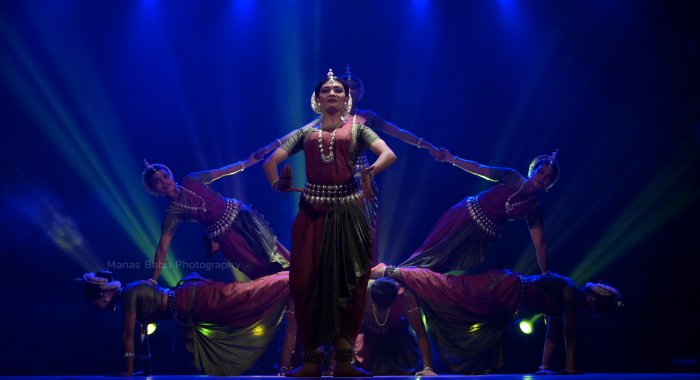 Srjan Ensemble in Vande Suryam The finale for the evening and for Raja Mahotsaba was by the Srjan Ensemble under the artistic direction of Guru Ratikant Mohapatra. In their signature neo-classical Odissi style, they presented two choreographs of Guru Ratikant, characterised by fast-paced movements, and innovations in dance and music. The first presentation, Shiva Shangsanam was by the seniormost members of the ensemble, Rajashri Praharaj, Ritu Sengupta, Aishwariya Singhdev, and Preetisha Mohapatra. Although based on the Odissi idiom, this presentation featured several movements that were unconventional to expectations. Dancing to the lyrics, Chandrachooda Shiva Shankara Gauri Ramana Yate Namo Namaha, the dancers paid obeisance to Lord Shiva. While the original Kriti was composed by Saint Purandara Dasa, the Sanskrit adaptation is by Pt. Nityananda Misra. The original music of Navaneeth Sundar, was adapted for this composition by Agnimitra Behera and Priyabrata Dash Mohapatra. They concluded with Vande Suryam, in obeisance to Surya Deva, tracing his resplendent course across the skies. This choreograph of Guru Ratikant Mohapatra is interlaced with aerobic formations and intricate footwork that test the grit, stamina, and body balance of the dancers. Each such formation was timed to a T, with characteristic coordination. Ensemble members Rajashri Praharaj, Aishwariya Singhdev, Preetisha Mohapatra, Sanjaya Kumar Behera, Madhabi Rout, G. Sanjay, Alisha Dhal, and Daina Ghose made the most of the brilliant light designing by Debiprasad Mishra presenting this well-practiced dance composition as the curtains drew to a close. 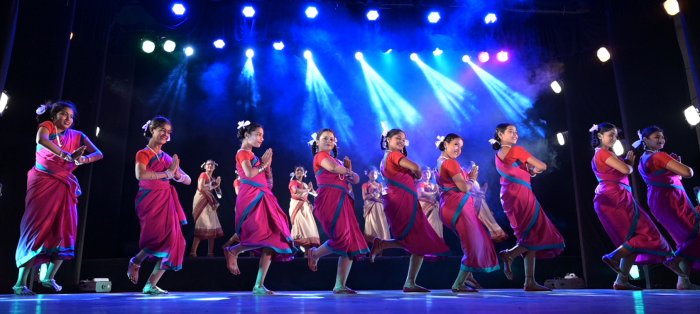 Sesha Raja by Soor Mandir Before the four-day spiel of dances came to an end, the students of Soor Mandir once again took to the stage with a Shesha Raja dance, bidding farewell to the audience and to the festival of Raja, till the calendar welcomes the celebration once again. All-in-all with its multitude of competitions and events ranging from food contests and rangoli-making, to the main cultural programme every evening, Soor Mandir presented a wholesome experience of Raja through this 25th year celebration. While each day presented an engaging mix of solo, duet, and group dances by some of the stalwarts of the classical Arts and their disciples, one wishes the formal felicitation and presentation ceremony before the commencement of the presentations would have been more succinct. This mild pruning of the program schedule would have added measurably to the anticipatory excitement of the well-curated festival. Watching the stalwarts of Odissi perform is a learning in itself. And we remain encouraged by events like this and inspired and humbled by the performances of our Gurus to continue our Art form with sincerity and hard work.  Maya Krishnamurty is a trained Odissi dancer, and freelance verbal trainer and language editor based in Bangalore. Maya holds a post-graduate diploma in Journalism and Mass Communication from Xavier Institute of Communications, Mumbai and has been learning Odissi for over a decade. |